Bridgeport, Connecticut

Bridgeport, Connecticut

Bridgeport, Connecticut | |
|---|---|
City | |
| City of Bridgeport | |
| Nicknames: The Park City | |
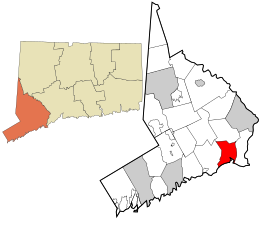 Location within Fairfield County | |
| Coordinates:41°11′11″N 73°11′44″W [102] | |
| Country | |
| U.S. state | |
| County | Fairfield |
| Metropolitan area | Bridgeport-Stamford |
| Incorporated (town) | 1821 |
| Incorporated (city) | 1836 |
| Government | |
| • Type | Mayor-council |
| • Mayor | Joe Ganim (D) |
| Area | |
| • City | 19.4 sq mi (50.2 km2) |
| • Land | 16.0 sq mi (41.4 km2) |
| • Water | 3.4 sq mi (8.8 km2) |
| • Urban | 9,014.3 sq mi (3,843.8 km2) |
| Elevation | 3 ft (1 m) |
| Population | |
| • City | 144,229 |
| • Estimate (2018)[2] | 144,900 |
| • Rank | US: 172nd |
| • Density | 8,720.9/sq mi (3,354/km2) |
| • Urban | 923,311 (US: 48th) |
| • Metro | 939,904 (US: 57th) |
| Time zone | UTC-5 (Eastern) |
| • Summer (DST) | UTC-4 (Eastern) |
| ZIP code | 06601, 06602, 06604, 06605, 06606, 06607, 06608, 06610, 06650, 06673, 06699[3] |
| Area code(s) | 203/475 |
| FIPS code | 09-08000 |
| GNIS feature ID | 0205720 |
| Airport | Sikorsky Memorial Airport |
| Major highways | |
| Commuter Rail | |
| Website | City of Bridgeport [103] |
Bridgeport is a historic seaport city in the U.S. state of Connecticut. It is in Fairfield County, at the mouth of the Pequonnock River on Long Island Sound, 60 miles (97 km) from Manhattan and 40 miles (64 km) from The Bronx. It is bordered by the towns of Trumbull to the north, Fairfield to the west, and Stratford to the east.
As of 2017, Bridgeport had an estimated population of 146,579,[4] which made it the largest city in Connecticut and the fifth-most populous in New England. The Greater Bridgeport area is the 48th-largest urban area in the United States.
The showman P. T. Barnum was a resident of the city and served as the town's mayor in the late 19th century. Barnum built four houses in Bridgeport and housed his circus in town during winter. The first Subway restaurant opened in Bridgeport's North End in 1965.[5] The Frisbie Pie Company was in Bridgeport, and Bridgeport is credited as the birthplace of the Frisbee.[6]
After World War II, industrial restructuring and suburbanization caused the loss of many jobs and affluent residents, leaving Bridgeport struggling with poverty and crime.
Bridgeport, Connecticut | |
|---|---|
City | |
| City of Bridgeport | |
| Nicknames: The Park City | |
 Location within Fairfield County | |
| Coordinates:41°11′11″N 73°11′44″W [102] | |
| Country | |
| U.S. state | |
| County | Fairfield |
| Metropolitan area | Bridgeport-Stamford |
| Incorporated (town) | 1821 |
| Incorporated (city) | 1836 |
| Government | |
| • Type | Mayor-council |
| • Mayor | Joe Ganim (D) |
| Area | |
| • City | 19.4 sq mi (50.2 km2) |
| • Land | 16.0 sq mi (41.4 km2) |
| • Water | 3.4 sq mi (8.8 km2) |
| • Urban | 9,014.3 sq mi (3,843.8 km2) |
| Elevation | 3 ft (1 m) |
| Population | |
| • City | 144,229 |
| • Estimate (2018)[2] | 144,900 |
| • Rank | US: 172nd |
| • Density | 8,720.9/sq mi (3,354/km2) |
| • Urban | 923,311 (US: 48th) |
| • Metro | 939,904 (US: 57th) |
| Time zone | UTC-5 (Eastern) |
| • Summer (DST) | UTC-4 (Eastern) |
| ZIP code | 06601, 06602, 06604, 06605, 06606, 06607, 06608, 06610, 06650, 06673, 06699[3] |
| Area code(s) | 203/475 |
| FIPS code | 09-08000 |
| GNIS feature ID | 0205720 |
| Airport | Sikorsky Memorial Airport |
| Major highways | |
| Commuter Rail | |
| Website | City of Bridgeport [103] |
History
Bridgeport was inhabited by the Paugussett native American tribe at the time of its English colonization. The earliest European communal settlement was in the historical Stratfield district,[7] along US Route 1; known in colonial times as the King's Highway. Close by, Mount Grove Cemetery was laid out on what was a native village that extended past the 1650s.[8] It is also an ancient Paugusett burial ground.
The English farming community grew and became a center of trade, shipbuilding, and whaling. The town incorporated to subsidize the Housatonic Railroad and rapidly industrialized following the rail line's connection to the New York and New Haven railroad. The namesake of the town was the need for bridges over the Pequonnock River that provided a navigable port at the mouth of the river. Manufacturing was the mainstay of the local economy until the 1970s.
Colonial history
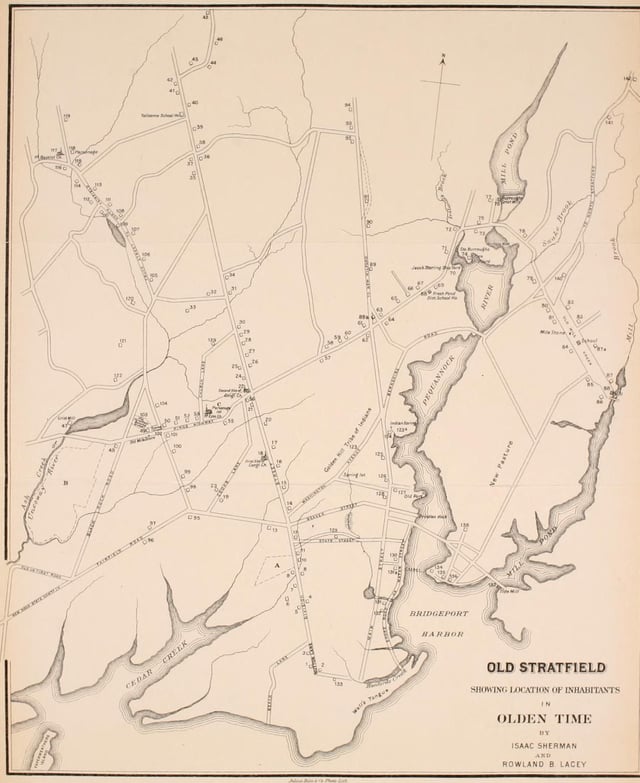
Colonial Stratfield, c.1886 map
The first documented English settlement within the present city limits of Bridgeport took place in 1644, centered at Black Rock Harbor and along North Avenue between Park and Briarwood Avenues. The place was called Pequonnock[9] (Quiripi for "Cleared Land"), after a band of the Paugussett, an Algonquian-speaking Native American people who occupied this area. One of their sacred sites was Golden Hill, which overlooked the harbor and was the location of natural springs and their planting fields. (It has since been blasted through for construction of an expressway.)[10][11] The Golden Hill Indians were granted a reservation here by the Colony of Connecticut in 1639; it lasted until 1802. (One of the tribe acquired land for a small reservation in the late 19th century that was recognized by the state. It is retained in the Town of Trumbull.)
Bridgeport's early years were marked by residents' reliance on fishing and farming. This was similar to the economy of the Paugusset, who had cultivated corn, beans, and squash; and fished and gathered shellfish from both the river and sound. A village called Newfield began to develop around the corner of State and Water streets in the 1760s.[12] The area officially became known as Stratfield in 1695[9] or 1701, due to its location between the already existing towns of Stratford and Fairfield.[13] During the American Revolution, Newfield Harbor was a center of privateering.[9][14]
19th century

Iranistan, the residence of P.T. Barnum, in 1848
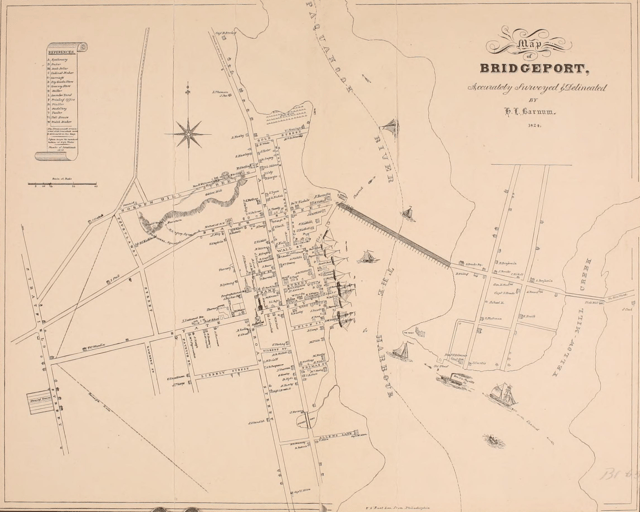
Bridgeport in 1824, by H. L. Barnum[15]

The route of the NY&NH, showing Bridgeport in 1845
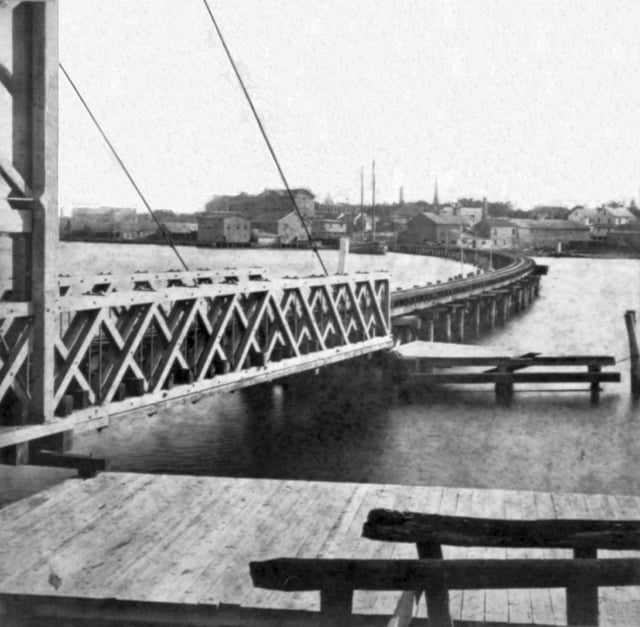
East Bridgeport Bridge over Pequannock River, ca. 1850
By the time of the State of Connecticut's ratification of the Articles of Confederation in 1781, many of the local farmers held shares in vessels trading at Newfield Harbor or had begun trading in their own name. Newfield initially expanded around the coasting trade with Boston, New York, and Baltimore and the international trade with the West Indies.[12][16] The commercial activity of the village was clustered around the wharves on the west bank of the Pequonnock, while the churches were erected inland on Broad Street.[15] In 1800, the village became the Borough of Bridgeport,[19] the first so incorporated in the state.[20] It was named for the Newfield or Lottery Bridge across the Pequonnock, connecting the wharves on its east and west banks.[18] Bridgeport Bank was established in 1806.[21] In 1821, the township of Bridgeport became independent of Stratford.[22]
The West India trade died down around 1840,[12] but by that time the Bridgeport Steamship Company (1824)[23] and Bridgeport Whaling Company (1833) had been incorporated[12] and the Housatonic Railroad chartered (1836).[24][25] The HRRC ran upstate along the Housatonic Valley, connecting with Massachusetts's Berkshire Railroad at the state line. Bridgeport was chartered as Connecticut's fifth city in 1836[22][26][29] in order to enable the town council to secure funding (ultimately $150,000) to provide to the HRRC and ensure that it would terminate in Bridgeport.[30] The Naugatuck Railroad—connecting Bridgeport to Waterbury and Winsted along the Naugatuck—was chartered in 1845 and began operation four years later.[31][32] The same year, the New York and New Haven Railroad began operation,[33] connecting Bridgeport to New York and the other towns along the north shore of the Long Island Sound.
Now a major junction for western Connecticut, the city rapidly industrialized. Following the Civil War, it held several iron foundries and factories manufacturing firearms, metallic cartridges, horse harnesses, locks, and blinds.[22] Wheeler & Wilson's sewing machines were exported throughout the world. Bridgeport annexed the West End and the village of Black Rock and its busy harbor in 1870.[34] In 1875, P. T. Barnum was elected mayor of the town, which afterwards served as the winter headquarters of Barnum and Bailey's Circus and Buffalo Bill's Wild West Show.[9]
20th century
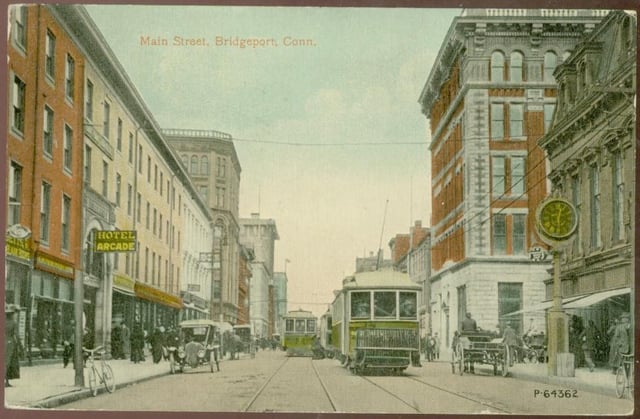
1912 postcard showing Main Street in Bridgeport

Sterling Block-Bishop Arcade, a Victorian-era shopping arcade
From 1870 to 1910, Bridgeport became the major industrial center of Connecticut and its population rose from around 25,000 to over 100,000, including thousands of Irish, Slovaks, Hungarians, Germans, English, and Italian immigrants.[9]
Further, the Holmes & Edwards Silver Co. was founded in 1882, with its wares sold nationally, and the company became part of the International Silver Company in 1898.[36] (The H&E brand, in fact, continued well into the 1950s and was advertised in national magazines such as LIFE and Ladies' Home Journal.)[37]
The town was also the center of America's corset production, responsible for almost 20% of the national total,[9] and became the headquarters of Remington Arms following its 1912 merger with the Union Metallic Cartridge Co. Around the time of the First World War, Bridgeport was also producing steam-fitting and heating apparatuses, brass goods, phonographs, typewriters,[9] milling machines, brassieres, and saddles.[38]
In the summer of 1915, a series of strikes imposed the eight-hour day on the town's factories; rather than moving business elsewhere, the success spread the eight-hour day throughout the Northeast.[39] The First World War continued the city's expansion so that, on the eve of the Great Depression, there were more than 500 factories in Bridgeport, including Columbia Records' primary pressing plant. The build-up to World War II helped its recovery in the late 1930s.[40]
Restructuring of heavy industry starting after the mid-20th century caused the loss of thousands of jobs and residents. Like other urban centers in Connecticut, Bridgeport suffered during the deindustrialization of the United States in the 1970s and 1980s.[41] Continued development of new suburban housing attracted middle and upper-class residents, leaving the city with a higher proportion of poor. The city suffered from overall mismanagement, for which several city officials were convicted, contributing to the economic and social decline.[42] In September 1978, Bridgeport teachers went on a 19-day strike due to deadlocked contract negotiations. A court order, as well as a state law that made strikes by public workers illegal in Connecticut, resulted in 274 teachers being arrested and jailed.[43] Bridgeport made numerous efforts at revitalization. In one proposal, Las Vegas developer Steve Wynn was to build a large casino, but that project failed. In 1991, the city filed for bankruptcy protection but was declared solvent by a federal court.[44]
21st century
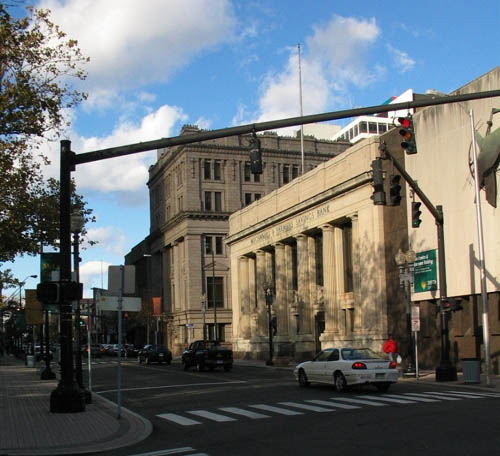
A street scene in Bridgeport
In the early 21st century, Bridgeport has taken steps toward redevelopment of its downtown and other neighborhoods. In 2004, artists' lofts were developed in the former Read's Department Store on Broad Street. Several other rental conversions have been completed, including the 117-unit Citytrust bank building on Main Street. The recession halted, at least temporarily, two major mixed-use projects including a $1-billion waterfront development at Steel Point, but other redevelopment projects have proceeded, such as the condominium conversion project in Bijou Square.[45] In 2009, the City Council approved a new master plan for development, designed both to promote redevelopment in selected areas and to protect existing residential neighborhoods.[46] In 2010, the Bridgeport Housing Authority and a local health center announced plans to build a $20 million medical and housing complex at Albion Street, making use of federal stimulus funds and designed to replace some of the housing lost with the demolition of Father Panik Village.[47] Recently, MGM announced plans to build a waterfront casino and shopping center in the city, awaiting approval by the state government. If built, the development will create 2,000 permanent jobs and about 5,779 temporary jobs.[48]
Notable speeches
On March 10, 1860, Abraham Lincoln spoke in the city's Washington Hall, an auditorium at the old Bridgeport City Hall (now McLevy Hall), at the corner of State and Broad Streets. The largest room in the city was packed, and a crowd formed outside, as well. Lincoln received a standing ovation before taking the 9:07 pm train that night back to Manhattan.[49][50] A plaque marks the site where Lincoln spoke; later that year, he was elected president.
The Rev. Martin Luther King, Jr. spoke three times at the Klein Auditorium during the 1960s. Additionally, President George W. Bush spoke before a small group of Connecticut business people and officials at the Playhouse on the Green in 2006.[51] President Barack Obama also spoke at the Harbor Yard arena in 2010 to gain support for the campaign of Democratic Governor Dan Malloy.[52]
Geography
Bridgeport lies along Long Island Sound at the mouth of the Pequonnock River.
Parks
Bridgeport is renowned for its public park system, which has led to its official nickname, "the Park City". The city's first public park was the westerly portion of McLevy Green, first set aside as a public square in 1806;[53] the Clinton Park Militia Grounds (1666) and Old Mill Green (1717) were set aside earlier as public commons by the towns of Fairfield and Stratford, respectively. As the city rapidly grew in population, residents recognized the need for more public parks and by 1864, Barnum and other residents had donated approximately 44 acres (180,000 m2) to create Seaside Park, now increased by acquisition and landfill to 375 acres (1.52 km2).[54] In 1878, over 100 acres (400,000 m2) of land bordering the Pequonnock River was added as Beardsley Park.[55] Frederick Law Olmsted, famous for creating New York City's Central Park, designed both Seaside and Beardsley Parks.[56] Over time, more parks were added including 35-acre (140,000 m2) Beechwood Park and Pleasure Beach, home to a popular amusement park for many years. Went Field on the West End, between Wordin Avenue and Norman Street, used to be the winter headquarters of Barnum's circus.
Neighborhoods
Downtown McLevy Green Harral Square The Hollow Enterprise Zone
East Side Boston Avenue/Mill Hill East End Lower East Side Newfield Pleasure Beach Steel Point Upper East Side
North End Brooklawn/St. Vincent Lake Forest Lake Success North Bridgeport/Little Italy Reservoir/Whiskey Hill
South End Seaside Park Soundgate
West Side Black Rock West Side
Climate
Under the Köppen climate classification, Bridgeport has a Temperate climate (Cfa), with some maritime influence; it is part of USDA hardiness zone 7a.[59] Like the rest of coastal Connecticut, Bridgeport lies in the broad transition zone between the continental climates of New England and the humid subtropical climates to the south. The average monthly temperature ranges from 30.1 °F (−1.1 °C) in January to 74.3 °F (23.5 °C) in July; on average, there are 20 days where the temperature remains at or below freezing and 7.6 days with a high at or above 90 °F (32 °C) annually; the last year to not reach the latter mark was 2004.[60] Temperatures reaching 0 °F (−18 °C) or 100 °F (38 °C) are uncommon, and were last seen respectively on January 7, 2018 and July 22, 2011.[60] The record low is −7 °F (−22 °C), set on January 22, 1984, while the record high is 103 °F (39 °C), set on July 22 in 1957 and 2011.[60]
Precipitation averages 42.7 inches (1,080 mm) annually, and is somewhat evenly distributed throughout the year, with March and April the wettest months. Annual snowfall averages 27.6 inches (70 cm), falling almost entirely from December to March. As is typical of coastal Connecticut, snow cover does not usually last long, with an average of 29 days per winter with snow cover of at least 1 inch (2.5 cm).
| Climate data for Bridgeport, Connecticut (Sikorsky Airport), 1981–2010 normals, extremes 1948–present | |||||||||||||
|---|---|---|---|---|---|---|---|---|---|---|---|---|---|
| Month | Jan | Feb | Mar | Apr | May | Jun | Jul | Aug | Sep | Oct | Nov | Dec | Year |
| Record high °F (°C) | 68 (20) | 67 (19) | 84 (29) | 91 (33) | 97 (36) | 97 (36) | 103 (39) | 100 (38) | 99 (37) | 89 (32) | 78 (26) | 76 (24) | 103 (39) |
| Mean maximum °F (°C) | 55.2 (12.9) | 55.4 (13.0) | 65.8 (18.8) | 76.4 (24.7) | 83.7 (28.7) | 89.9 (32.2) | 92.9 (33.8) | 91.4 (33.0) | 85.1 (29.5) | 76.6 (24.8) | 67.4 (19.7) | 58.6 (14.8) | 94.6 (34.8) |
| Average high °F (°C) | 37.1 (2.8) | 39.7 (4.3) | 47.2 (8.4) | 57.7 (14.3) | 67.6 (19.8) | 77.0 (25.0) | 82.2 (27.9) | 80.9 (27.2) | 74.0 (23.3) | 63.3 (17.4) | 53.1 (11.7) | 42.3 (5.7) | 60.2 (15.7) |
| Daily mean °F (°C) | 30.1 (−1.1) | 32.4 (0.2) | 39.3 (4.1) | 49.3 (9.6) | 59.1 (15.1) | 68.7 (20.4) | 74.3 (23.5) | 73.3 (22.9) | 66.2 (19.0) | 54.9 (12.7) | 45.5 (7.5) | 35.4 (1.9) | 52.4 (11.3) |
| Average low °F (°C) | 23.0 (−5.0) | 25.2 (−3.8) | 31.4 (−0.3) | 41.0 (5.0) | 50.6 (10.3) | 60.4 (15.8) | 66.4 (19.1) | 65.8 (18.8) | 58.3 (14.6) | 46.5 (8.1) | 38.0 (3.3) | 28.4 (−2.0) | 44.6 (7.0) |
| Mean minimum °F (°C) | 5.3 (−14.8) | 9.8 (−12.3) | 16.3 (−8.7) | 30.0 (−1.1) | 39.7 (4.3) | 49.5 (9.7) | 57.0 (13.9) | 54.9 (12.7) | 44.6 (7.0) | 33.4 (0.8) | 23.8 (−4.6) | 12.9 (−10.6) | 3.5 (−15.8) |
| Record low °F (°C) | −7 (−22) | −6 (−21) | 4 (−16) | 18 (−8) | 31 (−1) | 41 (5) | 49 (9) | 44 (7) | 36 (2) | 26 (−3) | 13 (−11) | −4 (−20) | −7 (−22) |
| Average precipitation inches (mm) | 3.10 (79) | 2.79 (71) | 4.05 (103) | 4.13 (105) | 3.80 (97) | 3.61 (92) | 3.46 (88) | 3.96 (101) | 3.48 (88) | 3.64 (92) | 3.39 (86) | 3.33 (85) | 42.74 (1,087) |
| Average snowfall inches (cm) | 7.7 (20) | 8.1 (21) | 5.1 (13) | 0.9 (2.3) | 0 (0) | 0 (0) | 0 (0) | 0 (0) | 0 (0) | 0 (0) | 0.7 (1.8) | 5.1 (13) | 27.6 (71.1) |
| Average precipitation days(≥ 0.01 inch) | 10.9 | 9.7 | 11.3 | 11.0 | 11.8 | 11.1 | 8.9 | 8.9 | 8.2 | 8.8 | 10.0 | 11.1 | 121.7 |
| Average snowy days(≥ 0.1 inch) | 4.8 | 3.5 | 2.4 | 0.3 | 0 | 0 | 0 | 0 | 0 | 0 | 0.5 | 3.1 | 14.6 |
| Source: NOAA[60][61] | |||||||||||||
Demographics
| Historical population | |||
|---|---|---|---|
| Census | Pop. | %± | |
| 1810 | 1,089 | — | |
| 1820 | 1,500 | 37.7% | |
| 1830 | 2,800 | 86.7% | |
| 1840 | 3,294 | 17.6% | |
| 1850 | 7,560 | 129.5% | |
| 1860 | 13,299 | 75.9% | |
| 1870 | 18,969 | 42.6% | |
| 1880 | 27,643 | 45.7% | |
| 1890 | 48,866 | 76.8% | |
| 1900 | 70,996 | 45.3% | |
| 1910 | 102,054 | 43.7% | |
| 1920 | 143,555 | 40.7% | |
| 1930 | 146,716 | 2.2% | |
| 1940 | 147,121 | 0.3% | |
| 1950 | 158,709 | 7.9% | |
| 1960 | 156,748 | −1.2% | |
| 1970 | 156,542 | −0.1% | |
| 1980 | 142,546 | −8.9% | |
| 1990 | 141,686 | −0.6% | |
| 2000 | 139,529 | −1.5% | |
| 2010 | 144,229 | 3.4% | |
| Est. 2018 | 144,900 | [2] | 0.5% |
| Population 1840–1970[62] U.S. Decennial Census[63] 2014 Estimate[64] | |||
As of the census of 2000, there were 139,529 people, 50,307 households, and 32,749 families residing in the city. The population density was 8,720.9 people per square mile (3,367.0/km²). There were 54,367 housing units at an average density of 3,398.1 per square mile (1,312.0/km²). The racial makeup of the city was 45.0% White, 30.8% African American, 0.5% Native American, 3.3% Asian, 0.1% Pacific Islander. Hispanic or Latino of any race were 20.3% of the population. Other ancestry groups include: Italian (8.6%), Irish (5.1%), Portuguese (2.9%), Polish (2.8%), and German (2.4%).[65]
As of the 2010 census, there were 144,229 people residing in the city. The racial makeup of the city residents was 39.6% White; 34.6% Black or African American; 3.4% Asian; and 4.3% from two or more races. A total of 38.2% of the population were Hispanic or Latino of any race.
There were 50,307 households out of which 34.3% had children under the age of 18 living with them, 35.0% were married couples living together, 24.0% had a female householder with no husband present, and 34.9% were non-families. 29.0% of all households were made up of individuals and 11.3% had someone living alone who was 65 years of age or older. The average household size was 2.70 and the average family size was 3.34.
In the city, the population was spread out with 28.4% under the age of 18, 11.2% from 18 to 24, 30.5% from 25 to 44, 18.4% from 45 to 64, and 11.5% who were 65 years of age or older. The median age was 31 years. For every 100 females, there were 91.2 males. For every 100 females age 18 and over, there were 86.3 males.
The median income for a household in the city was $34,658, and the median income for a family was $39,571. Males had a median income of $32,430 versus $26,966 for females. The per capita income for the city was $16,306. About 16.2% of families and 18.4% of the population were below the poverty line, including 24.8% of those under age 18 and 13.2% of those age 65 or over. Since 1849, FSWINC [104] , a 501(c)(3) nonprofit organization has provided care for individuals living in difficult socioeconomic situations in both Bridgeport and Fairfield.[66][67]
Economy
Since the decline of its industrial sector beginning in the middle of the 20th century, Bridgeport has gradually adjusted to a service-based economy. Though a level of industrial activity continues, healthcare, finance, and education have become the centerpieces of Bridgeport's economy.
The two largest employers in the city are Bridgeport's primary hospitals, Bridgeport Hospital and St. Vincent's Medical Center. Park City Hospital closed in 1993 and was reopened in 2010 as elderly and homeless housing units.[70] Emergency medical services are provided by American Medical Response at the paramedic level.
Top employers
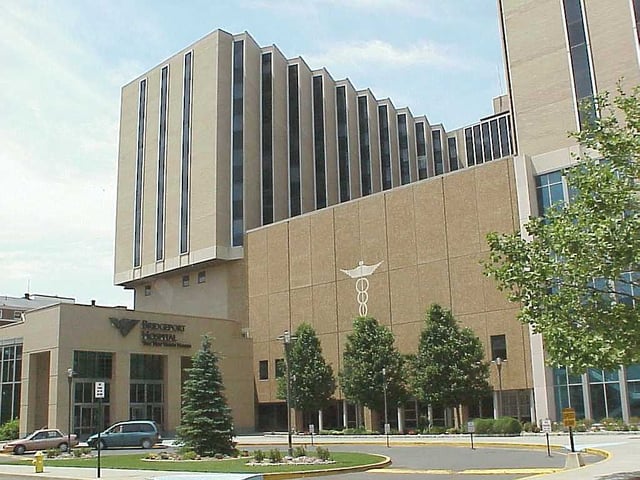
Bridgeport Hospital, an affiliate of the Yale School of Medicine

A portion of the harbor in Bridgeport: Facilities shown are part of the United Illuminating coal-fired power plant
According to the its 2009 Comprehensive Annual Financial Report,[71] the city's top employers are:
| Employer | of Employees |
|---|---|
| St. Vincent's Medical Center | 3,000 |
| Bridgeport Hospital | 2,622 |
| People's United Bank | 1,179 |
| University of Bridgeport | 875 |
| Bridgeport Health Care Center | 500 |
| Housatonic Community College | 482 |
| Prime Line | 310 |
| Derecktor Shipyards | 300 |
| Lacey Manufacturing | 275 |
| Watermark Retirement Communities | 165 |
Education
Higher education
Bridgeport is home to the University of Bridgeport, Housatonic Community College, St. Vincent's College, and the Yeshiva Gedola of Bridgeport. The Yeshiva Gedola is the home of the Bridgeport Community Kollel, a rabbinic fellowship program.[72]
The University of Bridgeport's Ernest C. Trefz School of Business offers undergraduate and graduate programs.
Public education
The city's public school system has 30 elementary schools, three comprehensive high schools, two alternative programs and an interdistrict vocational aquaculture school. The system has about 20,800 students, making the Bridgeport Public Schools the second largest school system in Connecticut after Hartford. It is ranked #158 out of the 164 Connecticut school districts.[73] The school system employs a professional staff of more than 1,700.
The city has started a large school renovation and construction program, with plans for new schools and modernization of existing buildings.
Public high schools
Bassick High School established in 1929.
Central High School established in 1876, home to Central Magnet, largest of the high schools.
Warren Harding High School home to the International Baccalaureate Program (IBO) and the Health Magnet Program in association with Bridgeport Hospital, St. Vincent's Medical Center, and Bridgeport Manor; also the alma mater of Walt Kelly, creator of Pogo.
Bridgeport Regional Vocational Aquaculture School (BRVAS), a school specializing in marine and aquaculture curricula near Captain's Cove and open to students from surrounding towns.
Bullard-Havens Technical High School, a vocational high school. (State School)
The Bridge Academy: Bridgeport Charter High School
Achievement First Bridgeport Charter High School
Public magnet schools
Fairchild Wheeler Interdistrict Multi-Magnet High School
Private education
Bridgeport is also home to private schools, including Bridgeport Hope School [105] (K-8), Bridgeport International Academy (grades 9-12), Catholic Academies of Bridgeport (PK-8), Kolbe Cathedral High School (9-12), St. Andrew Academy (PK-8), and St. Ann Academy (PK-8).
Government and politics
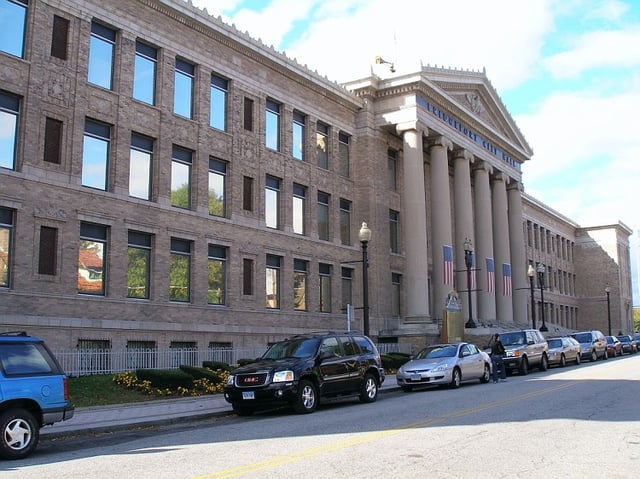
Bridgeport City Hall
The city is governed by the mayor-council system. Twenty members of the city council are elected from districts. Each district elects two members. The mayor is elected at-large by the entire city.
Bridgeport is notable for having had a socialist mayor for 24 years, Jasper McLevy, who served from 1933 to 1957.
| Voter registration and party enrollment as of October 27, 2015[76] | |||||
|---|---|---|---|---|---|
| Party | Active voters | Inactive voters | Total voters | Percentage | |
| Republican | 3,583 | 1,004 | 4,587 | 5.99% | |
| Democratic | 42,176 | 8,627 | 50,803 | 66.40% | |
| Unaffiliated | 15,474 | 5,348 | 20,822 | 27.21% | |
| Minor parties | 270 | 32 | 302 | 0.39% | |
| Total | 61,503 | 15,011 | 76,514 | 100% | |
Like most urban areas and big cities, Bridgeport is heavily Democratic at the presidential level. In 1972 Richard M. Nixon was the last Republican to win the city; since then Democrats have prevailed, often by comfortable margins, the lone exception being 1984 when Walter Mondale carried the city by just 76 votes (0.16 percent) over Ronald Reagan.
| Year | Democratic | Republican | Third Parties |
|---|---|---|---|
| 2016 | 80.98% 32,035 | 16.67% 6,596 | 2.35% 929 |
| 2012 | 85.75% 32,135 | 13.79% 5,168 | 0.46% 173 |
| 2008 | 83.52% 33,976 | 15.99% 6,507 | 4.89% 199 |
| 2004 | 70.66% 26,280 | 27.76% 10,326 | 1.57% 585 |
| 2000 | 72.68% 24,303 | 22.15% 7,406 | 5.18% 1,731 |
| 1996 | 69.16% 22,883 | 20.51% 6,785 | 10.33% 3,419 |
| 1992 | 53.20% 22,321 | 31.34% 13,149 | 15.46% 6,486 |
| 1988 | 57.50% 23,831 | 41.22% 17,084 | 1.27% 527 |
| 1984 | 49.75% 24,332 | 49.59% 24,256 | 0.66% 321 |
| 1980 | 51.24% 23,505 | 41.82% 19,185 | 6.94% 3,185 |
| 1976 | 55.37% 26,330 | 43.79% 20,824 | 0.83% 397 |
| 1972 | 43.67% 24,572 | 54.09% 30,436 | 2.25% 1,265 |
| 1968 | 53.27% 30,065 | 37.23% 21,014 | 9.50% 5,363 |
| 1964 | 69.90% 43,710 | 30.10% 18,818 | 0.00% 0 |
| 1960 | 61.14% 41,950 | 38.86% 26,667 | 0.00% 0 |
| 1956 | 38.57% 26,560 | 61.43% 42,308 | 0.00% 0 |
Taxes
Bridgeport has one of the highest property tax rates in Connecticut.[78] A 2017 Lincoln Institute of Land Policy and Minnesota Center of Fiscal Excellence study determined that Bridgeport had the second-highest property tax burden of any U.S. city (after Detroit), and the fourth-highest for commercial properties valued at more than $1 million (after Detroit, New York City, and Chicago).[79]
In 2016, Bridgeport enacted a 29% increase in the property tax rate, among the highest one-year property tax rate increases in recent U.S. history, in an effort to reduce the municipal deficit.[80] A citywide reassessment in 2015 determined that the value of taxable property in the city was $6 billion, a decline of $1 billion; the property tax increases, combined with property value decreases, have been a consistent political issue in the city.[80]
Culture
Performing arts
Theater and music
Bridgeport has a number of venues for live theater and music events, ranging from intimate performing spaces to a stadium hosting rock concerts.[81]
Downtown Cabaret Theatre – cabaret, children's theater, concerts
The Stress Factory – (300 seats) comedy club with national and local acts
Klein Memorial Auditorium – (1,400 seats) home to the Greater Bridgeport Symphony, touring shows and concerts
Webster Bank Arena – Sporting events venue, but also hosts large concerts
Music festivals and concert series
Bridgeport was the annual home to Gathering of the Vibes, a weekend-long arts, music and camping festival, until it ended in 2015.
The Greater Bridgeport Symphony, established in 1945, performs at Bridgeport's 1,400-seat Klein Memorial Auditorium. Gustav Meier directed the orchestra from 1972 to 2013.
Museums, zoos and parks
Bridgeport has a number of museums, ranging from the science-oriented to fine arts and historical, as well as the state's largest zoo.[81]
The Discovery Museum and Planetarium emphasizes exhibits on science, with the state's only Challenger Center, affiliated with the national space program.
The Housatonic Museum of Art at Housatonic Community College has the largest collection of art of any two-year college in the nation.
The Barnum Museum celebrates the showman, circuses and Bridgeport history.
The Beardsley Zoo is the only such center in Connecticut.
In popular culture
Movies
A list of films shot or partially filmed in the city:[82]
Officer Down (2012)
A Dance for Grace (2010)
Ironmen (2010)
3 Weeks to Daytona (2009)
Accidental Mayor (2009)
All Good Things (2009)
Confessions of a Shopaholic (2009)
Dear Beautiful (2009)
The Godfather Musical Part III: Luca Brasi Sleeps with the Fishes (2009)
House of Satisfaction (2009)
Made for Each Other (2009)
The Music of Erich Zann (2009/II)
Old Dogs (2009/I)
College Road Trip (2008)
Indiana Jones and the Kingdom of the Crystal Skull (2008)
Pistol Whipped (2008)
Righteous Kill (2008)
The Sisterhood of the Traveling Pants 2 (2008)
What Just Happened (2008)
Bobby Dogs (2007)
Dear Beautiful (2007)
Praying to Hendrix (2007)
Die Hard with a Vengeance (1995)
A Walk with Death (1993)
Route One USA (1989)
There's a Nightmare in My Closet (1987)
Without a Trace (1983)
The Case of the Cosmic Comic (1976)
The Effect of Gamma Rays on Man-in-the-Moon Marigolds (1972)
The Light that Failed (1916)
Television
Kitchen Nightmares (Season 4, Episode 7, "Tavolini Restaurant", 2011)
Brian Boitano Skating Spectacular (2010) (TV)
Ghost Adventures:"Remington Arms Factory" (Episode 21, November 2009)
WWE Raw (Nov. 18, 2002; Mar. 8, 2004; Dec. 26, 2005; August 21, 2006; April 9, 2007; April 27, 2009; June 21, 2010, April 11, 2011 and Sep 17, 2012)
WWE Smackdown, ECW, and NXT (May 7, 2002; March 4, 2003; August 2, 2005; Dec. 9, 2008; Nov. 24, 2009; Nov. 2, 2010; and Nov. 15, 2011)
Oprah Winfrey Presents: Mitch Albom's For One More Day (2007)
WWE Raw's 15th Anniversary Special (2007)
Flip This House: "Burning Down the House" (2005)
Extreme Makeover: Home Edition (2003 & 2007)
Made in America (2003)
U.S. Bounty Hunter (2003)
Muggsy (1976)
The Twentieth Century (1957, The Class of '58 episode)
Johnny, We Hardly Knew Ye (TV Movie, 1977), bar scene of JFK campaigning with local workers filmed in the Ideal Bar on Barnum Avenue across from the former Singer Building
Live PD (2016-)
Sneaky Pete (2015-) Although shot in the state of New York, the show takes place in Bridgeport
Novels
Bridgeport is the setting of Maureen Howard's novel Natural History, which includes scenes from the city's history and depicts historical figures such as P. T. Barnum.
Sports
| Club | League | Venue | Established | Championships | Logo |
|---|---|---|---|---|---|
| Bridgeport Sound Tigers | AHL, Ice hockey | Webster Bank Arena | 2001 | 0 |
Webster Bank Arena serves as the city's sports and hospitality center. Seating 10,000, the Arena serves as the home rink of the Bridgeport Sound Tigers AHL hockey team and the Sacred Heart University's men's hockey team and as the home court of Fairfield University's basketball team.
The Ballpark at Harbor Yard served as a minor-league baseball stadium from 1998 to 2017. It was built in 1998 to serve as the homefield of the Bridgeport Bluefish. From 2001 to 2003 it was the homefield for the Bridgeport Barrage, a Major League Lacrosse team. It is located downtown on a former brownfield site. It is visually prominent to commuters on I-95 or on passing trains. On August 8, 2017, Mayor Joe Ganim announced that the Bluefish would be ending their 20 year stint at the ballpark at the end of the 2017 season. The ballpark is expected to be converted to an amphitheatre. The Bluefish played their final home game at the park on September 17, 2017, losing by a score of 9–2 to the Somerset Patriots.[83]
Kennedy Stadium serves as a community sports facility. In the late 1960s and early 1970s, it was the home of an Atlantic Coast Football League minor league football team, the Bridgeport Jets, a New York Jets farm team also known locally as the Hi-Ho Jets due to their sponsorship by the (Hi-Ho) D'Addario construction company.
Fairfield University is located in the neighboring town of Fairfield, and many of the athletic teams play on campus. Only the men's and women's basketball teams play in Bridgeport.
Bridgeport has a storied history in professional sports. Bridgeport native Jim O'Rourke was the first baseball player to earn a hit in National League history in 1876. The founder and original owner of the Brooklyn Dodgers, Charles Ebbets, married his second wife in Bridgeport in 1922, five years before his death.
Media
Radio
WCUM AM 1450; 1,000 watts (formerly WJBX-AM, and before that, WNAB-AM) Spanish Format station better known as Radio Cumbre.
WDJZ AM 1530; 5,000 watts (daytime only) Gospel Radio that serves the African American and Caribbean communities in the Bridgeport Metro Area.
WICC-AM 600; 1,000 watts (daytime), 500 watts (nighttime) – WICC began broadcasting on November 21, 1926, when a previous radio station, WCWS, was given a new name, WICC. The last three letters standing for Industrial Capitol of Connecticut. The Bridgeport Broadcasting Company Inc. was the new station's owner. Back then, the station was powered at 500 watts. From 1951 to 1956 one of the station's radio hosts was Bob Crane, who later went on to play Col. Robert Hogan on the Hogan's Heroes television comedy series.[85] WICC's transmitter is located on Pleasure Beach, an island located between Downtown Bridgeport and Long Island Sound.
WEBE-FM 107.9; 50,000 watts. WEBE108 is "Connecticut's Best Music Variety!" owned and operated by Connoisseur Media. Licensed to Westport, CT, with studios in Bridgeport and transmitter on Bridgeport Harbor.
WEZN-FM 99.9; 27,500 watts (formerly WJZZ-FM). Star 99.9 is "Today's Best Mix!" The station owned by Connoisseur Media. Lincensed to Bridgeport, CT, with studios in Milford and transmitter in Shelton.
WPKN-FM 89.5; 10,000 watts[86]
Due to Bridgeport's close proximity to Long Island Sound, many radio stations from New York and Long Island are received clearly in the market. These include WMCA, WFAN, WOR, WABC, WNYC, WCBS, WEPN, WQEW, WBLI, and WALK.[87]
Newspapers
Elsolnews.com, a community Spanish language weekly newspaper covering news and events.
Connecticut Post – Formerly the Bridgeport Post and Bridgeport Telegram, which covers Bridgeport and the surrounding area. The newspaper is printed daily.
Television
Bridgeport was NBC's pioneer UHF TV test site from December 29, 1949 to August 23, 1952;[88] the equipment from the "Operation Bridgeport" tests was later deployed commercially at KPTV in Portland, Oregon (1952–1957). While Bridgeport is primarily served by New York City stations, some local UHF broadcasters operate today:
WEDW channel 49; one of the Connecticut Public Television stations, broadcasts from Bridgeport and can be seen in Hartford.
In 2011, WTNH-TV opened a satellite studio in the offices of the Connecticut Post Downtown on State Street.
WZME channel 43; a Sonlife Broadcasting Network affiliate, currently channel sharing with WEDW and licensed to Bridgeport.
Transportation
Airports
Sikorsky Memorial Airport in neighboring Stratford was previously owned by the City of Bridgeport before closing a deal in 2016 that sold the land to Stratford. It once provided regional flights to major cities, but commercial operations at the airport were terminated in November 1999.
Roads
Surface thoroughfares
The main portion of the city is divided by major north/south roads that approximately parallel each other:
Main Street, the city's principal artery, extends from the Trumbull town line down through the North End, under Routes 8/25, and into Downtown, with its southern terminus at Seaside Park. The portion north of State Street was laid out as the "Newtown Turnpike" in 1795. Porter Street, Beechmont Avenue, and Kaechele Place are former curves in this highway that were lopped off as the road was straightened in the 19th century.
Park Avenue lies on the border with the town of Fairfield (north of its intersection with Brooklawn Avenue) and extends from the Trumbull, Connecticut border in the North End to the South End at Seaside Park. It was known as "Division Street" until 1867. It is the easternmost of the "11 o'clock" roadways laid out in 17th-century Fairfield (their north-northwesterly direction points them like a clock's hands at that hour, exactly perpendicular to the shoreline of Long Island Sound, which facilitated land distribution).
Clinton/Brooklawn Avenues are a central artery through the West End, extending north from Railroad Avenue to the Fairfield line at the Rooster River. The portion north of Fairfield Avenue was laid out in the 17th century at the center of the agricultural village of Stratfield. It was known as Stratfield Road until 1870.
Brewster Street extends from Black Rock Harbor north to the Fairfield line at Ash Creek, and is the major north-south artery through the Black Rock neighborhood. This was the southernmost portion of the "Black Rock Turnpike," a late-18th century toll road that extended as far north as Danbury.
Madison Avenue is between Main Street and Park Avenue and extends from the Trumbull town line in the North End through the West Side. It was formerly known as Chestnut Hill Road and follows the route of an Indian path.
Reservoir Avenue was part of a turnpike laid out in 1817 in an almost straight line from Bridgeport north to the Monroe Green (it followed Daniels Farm Road in Trumbull and Moose Hill Road in Monroe). The "Reservoir" was a stone structure at the intersection of Sylvan Avenue, to which water was pumped from nearby Bunnell's Pond, and from which water was supplied to the city by gravity. Until construction of the Route 25-8 Expressway, this street extended south to North Avenue.
Noble Avenue extends from the corner of Congress Street just south of Washington Park to the intersection of East Main Street and Huntington Turnpike. The portion below Boston Avenue was laid out in 1850 as Noble Street; the part to the north was added to connect with the entrance to the new Beardsley Park in 1878.
East Main Street is the major north/south road through East Bridgeport, extending from the Trumbull/Stratford line though the East Side, ending at Bridgeport Harbor. The portion south of Boston Avenue/Old Mill Green was laid out in 1800.
Huntington Road/Huntington Turnpike is the major roadway through the Upper East Side, extending northeast from the Berkshire Bridge to the Trumbull town line (a small portion today is part of East Main Street). It was one of a number of turnpikes laid out in the immediate post-Revolutionary period to funnel rural commerce to the fledgling city's seaport, and formerly extended to the city center by way of North Washington Avenue.
Seaview Avenue runs the length of the East End neighborhood on the East shore of Pembroke Lake, Yellow Mill Pond, and Bridgeport Harbor. It extends northwest from Central to Stratford Avenues, then due north from Stratford to Boston Avenues. It was laid out at the time of the Civil War in three sections that were later connected: Sea View Avenue south of Stratford Avenue; West Avenue at Deacon's Point, from Sixth Street North to the railroad tracks; and Lake Avenue, from Barnum Avenue North to Boston Avenue.
Central/Palisade Avenues were laid out as farm highways through the western portions of what was the town of Stratford in the early 19th century. They form a north-south axis through the center of today's East End. The portion of Central Avenue north of Barnum Avenue was known as Prospect Street from the 1860s through 1889 due to the vistas from its hillside location.
The major east/west roads in the city include Barnum Avenue, Boston Avenue, Fairfield Avenue/Stratford Avenue, North Avenue, Capitol Avenue, State Street, and Railroad Avenue:
Barnum Avenue extends from the Stratford line, below Old Mill Hill, and ends at the Pequonnock River. The portion through the East Side was laid out as Barnum Street in 1850. From Pembroke Lake to Mill Hill Avenue was added in 1863. The road from Mill Hill Avenue to the Washington Bridge between Stratford and Milford was laid out as the Air Line Highway in 1870.
Boston Avenue breaks off from Barnum Avenue near the Bridgeport line in Stratford and travels east-west over Old Mill Hill to the Upper East Side toward the North End. It follows the route of an Indian path, crossing Old Mill Brook and the Pequonnock River and the southernmost points where they were fordable, which became the Post Road in the 1670s.
Stratford Avenue starts in the South End of the town of Stratford and travels southwest through the East End. It then travels east through East Bridgeport directly into the center of downtown Bridgeport, where it turns into Fairfield Avenue at Water Street. It was laid out in 1795 as a more direct route for the Post Road, and the bridge built that year over the Pequonnock was the origin of the name "Bridgeport." Connecticut Avenue, which parallels it one block north through the East End, is a one-way street heading west, while Stratford Avenue is one-way heading east.
Fairfield Avenue extends west and then southwest through the West End and into Black Rock, where it turns into the Boston Post Road, or simply the Post Road, at the Fairfield line. Its route through the West End parallels what had been the northern edge of an extensive salt marsh, and existed in the 18th century. The portion through Black Rock was added in the 1870s.
North Avenue begins at Boston Avenue where the East Side abuts the Island Brook neighborhood at the Pequonnock River and extends southwest diagonally through the city as US 1. It then turns into Kings Highway in Fairfield. As with Boston Avenue, it follows an Indian trail, and was formalized as a part of the New York-to-Boston Post Road in the 1670s.
Capitol Avenue begins by breaking off from North Avenue at Island Brook Avenue Extension. It travels west across the Old North End and Brooklawn neighborhoods and ends at the Fairfield line.
State Street begins downtown and cuts across the West End, where it terminates (as State Street Extension) at the Fairfield line. The portion from Park Avenue to Bridgeport Harbor was in existence by the 1760s; the part west of Park Avenue was extended across what was then marshy terrain in 1867.
Atlantic Street bisects the South End neighborhood, historically separating the well-to-do residential district that adjoined the old portion of Seaside Park from the working-class blocks to the north. Today it forms the north border of the University of Bridgeport campus.
Railroad Avenue extends from Broad Street just below downtown Bridgeport and runs parallel with the Metro North/New Haven Railroad lines. The westbound side is north of the tracks, and the eastbound side south of them. It terminates at Fairfield Avenue in the West End.
Highways
Bridgeport has several major roadways. Interstate 95 and the Route 8/Route 25 Connector meet in Downtown Bridgeport. I-95 runs east-west near the coast heading towards New York City to the southwest and Providence to the northeast. Routes 8 and 25 run north-south across the city, with the two routes splitting just north of the city. Route 8 continues towards Waterbury and Torrington and Route 25 continues towards the Danbury area. Both Routes 8 and 25 connect to the Merritt Parkway in the adjacent town of Trumbull.
Other major surface arteries are U.S. 1 (the Boston Post Road), which runs east-west north of Downtown, and Main Street, which runs north-south towards Trumbull center. The city also has several secondary state highways, namely, Route 127 (East Main Street), Route 130 (Connecticut Avenue, Stratford Avenue, Fairfield Avenue and Water Street), and the Huntington Turnpike.
Railroad and ferries
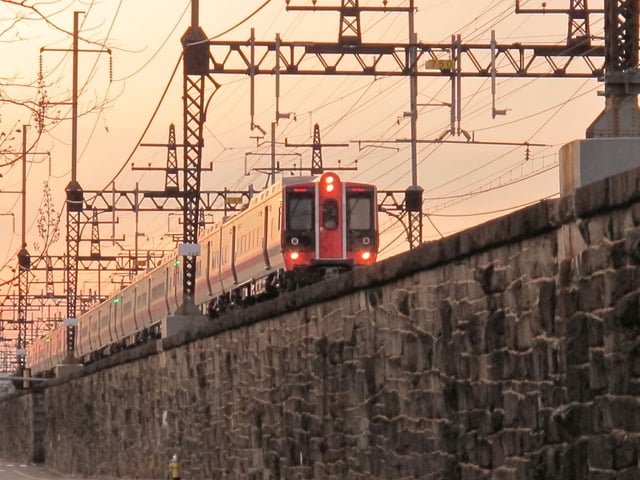
A New Haven Line train approaches the intermodal transit hub at Bridgeport Station
The Bridgeport Traction Company provided streetcar service in the region until 1937. The Housatonic Railroad carried passengers North through the Pequonnock and Housatonic Valleys prior to 1933.
The city is connected to nearby New York City by both Amtrak and Metro-North commuter trains, which serve Bridgeport's Metro-North station. Many residents commute to New York jobs on these trains, and the city to some extent is developing as an outpost of New York–based workers seeking cheaper rents and larger living spaces. Connecting service is also available to Waterbury via Metro-North, and New Haven via Amtrak and Metro-North. Shoreline East service links Old Saybrook and New London with New Haven, which extends to Bridgeport and Stamford during weekday rush hours only.
The Bridgeport & Port Jefferson Ferry service runs from Bridgeport across Long Island Sound to Port Jefferson, New York; the three vessels Grand Republic, P.T. Barnum, and Park City transport both automobiles and passengers.
Buses
The Greater Bridgeport Transit Authority (GBTA) provides bus service to Bridgeport and its immediate suburbs. Route 2 the Coastal Link goes west to Norwalk and east to Westfield's Connecticut Post Mall in Milford, from where Connecticut Transit can bring passengers to the New Haven Green. Greyhound and Peter Pan Bus Lines both offer intercity bus service to points throughout the Northeast and points beyond.
Historic sites
Historic districts
Bridgeport has five local historic districts, where exterior changes to structures are under the control of two Historic District Commissions:
Black Rock Harbor Historic District, 88 buildings along Ellsworth, Brewster, and Beacon Streets, includes the village center of a historic seaport, with buildings that date back to the 17th century, one of the original English settlements in Bridgeport.
Pembroke City Historic District, 266 buildings in a general two-block radius of Washington Park, a planned residential development constructed 1850–1900 that contains the city's most important concentration of Victorian architecture.
Stratfield Historic District, 300 buildings along Clinton, Brooklawn, and Laurel Avenues that made up an elite residential district of the Edwardian era and has the original 17th century town green, Clinton Park Militia Ground, and the city's oldest cemetery, Stratfield Burying Ground, also dating back to the 17th century. This area along North Avenue is the other original English settlement in what is now Bridgeport.
Barnum-Palliser Development Historic District, 33 buildings on Austin, Gregory, and Atlantic Streets and Myrtle Avenue that was a planned working-class development of the 1880s designed by the architectural firm of Palliser, Palliser, and Company.
Marina Park Historic District, 14 buildings along South Park Avenue and Marina Park, contains some of the city's most opulent late 19th-early 20th century mansions overlooking Seaside Park.
See also
History of Bridgeport, Connecticut
National Register of Historic Places listings in Bridgeport, Connecticut
List of people from Bridgeport, Connecticut
St. Andrew Church (Bridgeport, Connecticut)
Seaside Village Historic District



